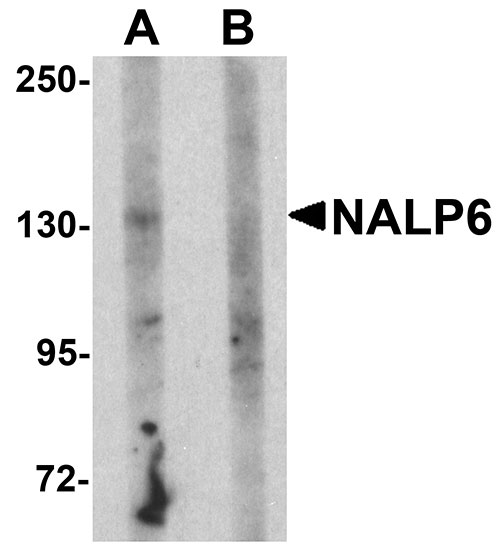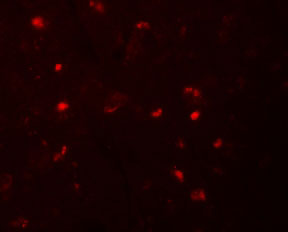NALP6 Antibody
- SPECIFICATION
- CITATIONS: 2
- PROTOCOLS
- BACKGROUND

Application
| WB, IF, E |
|---|---|
| Primary Accession | P59044 |
| Other Accession | NP_612202, 21264320 |
| Reactivity | Human |
| Host | Rabbit |
| Clonality | Polyclonal |
| Isotype | IgG |
| Calculated MW | 98768 Da |
| Application Notes | NALP6 antibody can be used for detection of NALP6 by Western blot at 1 µg/mL. Antibody can also be used for immunoflourenscence starting at 20 µg/mL. For immunofluorescence start at 20 µg/mL. |
| Gene ID | 171389 |
|---|---|
| Target/Specificity | NLRP6; |
| Reconstitution & Storage | NALP6 antibody can be stored at 4℃ for three months and -20℃, stable for up to one year. As with all antibodies care should be taken to avoid repeated freeze thaw cycles. Antibodies should not be exposed to prolonged high temperatures. |
| Precautions | NALP6 Antibody is for research use only and not for use in diagnostic or therapeutic procedures. |
| Name | NLRP6 {ECO:0000303|PubMed:21088234, ECO:0000312|HGNC:HGNC:22944} |
|---|---|
| Function | Acts as the sensor component of the NLRP6 inflammasome, which mediates inflammasome activation in response to various pathogen- associated signals, leading to maturation and secretion of IL1B and IL18 (PubMed:30392956, PubMed:34678144). Inflammasomes are supramolecular complexes that assemble in the cytosol in response to pathogens and other damage-associated signals and play critical roles in innate immunity and inflammation (PubMed:30674671). Acts as a recognition receptor (PRR): recognizes and binds specific pathogens and other damage-associated signals, such as lipoteichoic acid (LTA), a cell-wall component of Gram-positive bacteria, or double stranded RNA (dsRNA) (PubMed:30392956, PubMed:33377178, PubMed:34678144). May also recognize and bind lipopolysaccharide (LPS), a major component of the outer membrane of Gram-negative bacteria; however, LPS is probably not a major activator of the NLRP6 inflammasome (PubMed:31932628, PubMed:34678144). Following LTA- or dsRNA-binding, NLRP6 undergoes liquid-liquid phase separation (LLPS), enhancing multivalent interactions, an essential step for the formation of the NLRP6 inflammasome polymeric complex (PubMed:34678144). The NLRP6 inflammasome acts by promoting recruitment of effector pro-inflammatory caspases (CASP1 and/or CASP4) that catalyze maturation and secretion of IL1B and IL18 in the extracellular milieu (PubMed:12387869, PubMed:30392956, PubMed:30674671, PubMed:34678144). The NLRP6 inflammasome plays a central role in the maintenance of epithelial integrity and host defense against microbial infections in the intestine (PubMed:30392956). Required to restrict infection against Gram-positive bacteria by recognizing lipoteichoic acid (LTA), leading to recruitment of CASP4 and CASP1, and subsequent maturation and secretion of IL1B and IL18 (PubMed:30392956, PubMed:33377178). Involved in intestinal antiviral innate immunity together with DHX15: recognizes and binds viral dsRNA to restrict infection by enteric viruses through the interferon pathway and GSDMD-dependent release of IL18 (PubMed:34161762, PubMed:34678144). Required to prevent infection by the apicomplexan parasite Cryptosporidium in enterocytes by promoting GSDMD-dependent release of IL18 (By similarity). The NLRP6 inflammasome may also regulate the gut microbiota composition by acting as a sensor of microbiota-associated metabolites to form a PYCARD/ASC-dependent inflammasome for downstream IL18 release and secretion of antimicrobial peptides (By similarity). Essential for gut mucosal self-renewal and proliferation (By similarity). Regulate mucus secretion in an inflammasome- and autophagy-dependent manner to prevent invasion by enteric bacteria, (By similarity). During systemic bacterial infections, the NLRP6 inflammasome negatively regulates neutrophil recruitment and neutrophil extracellular traps (NETs) formation (By similarity). May promote peripheral nerve recovery following injury via an inflammasome-independent mechanism (By similarity). |
| Cellular Location | Cytoplasm, cytosol. Inflammasome. Cell membrane {ECO:0000250|UniProtKB:Q63035}. Nucleus membrane {ECO:0000250|UniProtKB:Q63035} |
| Tissue Location | Expressed in peripheral blood leukocytes, predominantly in granulocytes and, at lower levels, in CD4(+) and CD8(+) T-cells (PubMed:12387869). Expressed in colonic myofibroblasts (at protein level) (PubMed:21593405). |

Provided below are standard protocols that you may find useful for product applications.
Background
NALP6 Antibody: NALP proteins include the apoptosis regulator APAF1 (apoptotic protease activating factor 1) and mammalian NOD-LRR proteins and are thought to be involved in inflammation and reproduction. NALP6, also known as PYPAF5, is highly expressed in granulocytes and T cells and co-localizes with the PYRIN-CARD protein ASC. Co-expression of NALP6 with ASC results in a synergistic activation of NF-κB and activated caspase-1-dependent cytokine processing, suggesting that NALP6 functions in immune cells to coordinate the transduction of pro-inflammatory signals.
References
Tschopp J, Martinon F, and Burns K. NALPs: a novel protein family involved in inflammation. Nat. Rev. Mol. Cell Biol.2003; 4:95-104.
Tian X, Pascal G, and Monget P. Evolution and functional divergence of NLRP genes in mammalian reproductive system. BMC Evol. Biol.2009; 9:202.
Grenier JM, Wang L, Manji GA, et al. Functional screening of five PYPAF family members identifies PYPAF5 as a novel regulator of NF-kappaB and caspase-1. FEBS Lett.2002; 530:73-8.
If you have used an Abcepta product and would like to share how it has performed, please click on the "Submit Review" button and provide the requested information. Our staff will examine and post your review and contact you if needed.
If you have any additional inquiries please email technical services at tech@abcepta.com.














 Foundational characteristics of cancer include proliferation, angiogenesis, migration, evasion of apoptosis, and cellular immortality. Find key markers for these cellular processes and antibodies to detect them.
Foundational characteristics of cancer include proliferation, angiogenesis, migration, evasion of apoptosis, and cellular immortality. Find key markers for these cellular processes and antibodies to detect them. The SUMOplot™ Analysis Program predicts and scores sumoylation sites in your protein. SUMOylation is a post-translational modification involved in various cellular processes, such as nuclear-cytosolic transport, transcriptional regulation, apoptosis, protein stability, response to stress, and progression through the cell cycle.
The SUMOplot™ Analysis Program predicts and scores sumoylation sites in your protein. SUMOylation is a post-translational modification involved in various cellular processes, such as nuclear-cytosolic transport, transcriptional regulation, apoptosis, protein stability, response to stress, and progression through the cell cycle. The Autophagy Receptor Motif Plotter predicts and scores autophagy receptor binding sites in your protein. Identifying proteins connected to this pathway is critical to understanding the role of autophagy in physiological as well as pathological processes such as development, differentiation, neurodegenerative diseases, stress, infection, and cancer.
The Autophagy Receptor Motif Plotter predicts and scores autophagy receptor binding sites in your protein. Identifying proteins connected to this pathway is critical to understanding the role of autophagy in physiological as well as pathological processes such as development, differentiation, neurodegenerative diseases, stress, infection, and cancer.


